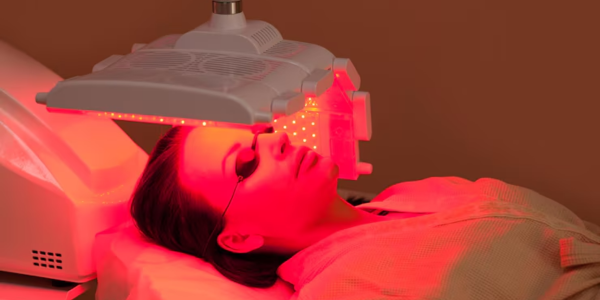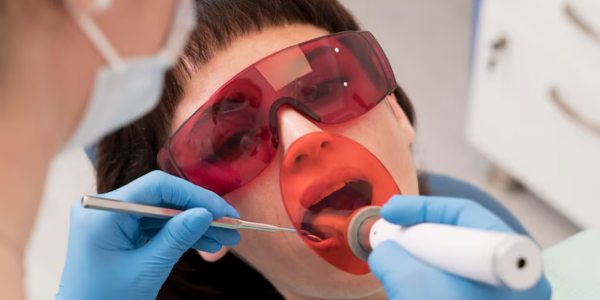Red Light Therapy for Teeth Whitening
Red Light Therapy for Teeth Whitening: The Future of a Brighter Smile

If you’re searching for safe, non-invasive ways to enhance your smile, you’ve probably come across red light therapy.
Known for its wide range of health benefits, red light therapy is now gaining attention in the cosmetic world, particularly for teeth whitening. But how exactly does it work? And is it truly effective? Let’s break it down.
What Is Red Light Therapy?
Red light therapy (RLT) is a non-invasive treatment that uses low-wavelength red light to stimulate natural biological processes in the body.
Unlike ultraviolet (UV) light, which can burn or damage tissues, red light is safe, gentle, and penetrates deep into skin and soft tissues without causing harm.
This light energy is absorbed by mitochondria, the energy centers of cells promoting increased energy production, faster healing, and reduced inflammation.
Historically, red light therapy has been used to accelerate wound healing, improve joint health, reduce chronic pain, and rejuvenate the skin by boosting collagen production.
Its applications are now expanding into dental care, where red light shows promise in promoting healthier gums, reducing oral bacteria, and even supporting teeth whitening efforts.
With no downtime, no pain, and minimal risk, red light therapy is quickly becoming a popular, science-backed tool for both medical and cosmetic enhancements.
The Science Behind Red Light Therapy for Teeth Whitening
Traditional teeth whitening treatments often rely on peroxide-based solutions. These can cause sensitivity, gum irritation, and enamel damage with repeated use. Red light therapy offers a different approach.
When red light penetrates oral tissues and the enamel surface, it stimulates cellular activity and increases blood flow.
This enhances the natural repair processes and may help break down stains at a molecular level. It also reduces inflammation in the gums, which can contribute to an overall healthier-looking smile.
Although red light alone isn’t a bleaching agent, when combined with certain gels or used alongside mild whitening agents, it can significantly boost the teeth whitening process.
How Red Light Therapy Is Used for Teeth Whitening?
Typically, red light therapy for teeth whitening involves a specialized device, often a mouthpiece or panel fitted with red LED lights. Here’s the general process:
- Preparation: The mouth is cleaned to remove plaque and debris.
- Application: Sometimes, a gentle whitening gel is applied to the teeth.
- Exposure: The red light device is used for a set period, usually between 5 to 20 minutes.
- Post-Care: Rinsing and a brief waiting period to let the treatment settle.
Users typically undergo multiple sessions over days or weeks to see significant results.
Benefits of Using Red Light Therapy for Teeth Whitening
1. Minimized Sensitivity
- One of the biggest drawbacks of traditional whitening is tooth sensitivity. Red light therapy minimizes this side effect by promoting cellular health and reducing inflammation.
2. Non-Invasive and Pain-Free
- There’s no drilling, no abrasive agents, and no risk of damaging enamel when properly used. The process is gentle enough for regular use.
3. Dual Benefits: Whitening and Oral Health
- Besides enhancing the appearance of your teeth, red light therapy supports gum health by improving blood circulation and reducing harmful bacteria.
4. At-Home Convenience
- Many companies now offer affordable red light therapy kits that can be safely used at home, saving you trips to the dentist.
5. Natural and Sustainable Results
- Since the therapy works with your body’s natural processes, results can appear more gradual but tend to look more natural and be longer-lasting.

Red Light Therapy vs. Blue Light Therapy for Teeth Whitening
When it comes to light-based teeth whitening, not all light therapies work the same way. Understanding the key differences between red and blue light can help you choose the best approach for your smile goals.
-
Blue Light Therapy: Blue light is typically used alongside peroxide-based whitening gels. Its main role is to activate and accelerate chemical reactions that break down stains on the tooth surface. Blue light treatments can deliver fast, noticeable whitening results, often after just one session. However, they may also increase tooth sensitivity and gum irritation in some people, especially with repeated exposure.
-
Red Light Therapy: Red light takes a different path. Instead of chemically lifting stains, it enhances oral tissue health by stimulating blood flow, reducing inflammation, and supporting cellular regeneration. This improved gum health and bacterial balance create a naturally brighter and healthier-looking smile over time. Red light therapy is especially ideal for those who experience sensitivity with traditional whitening methods.
Today, many advanced teeth whitening systems incorporate both red and blue light technologies.
This dual-light approach allows users to enjoy the immediate stain removal benefits of blue light while leveraging the healing and protective effects of red light for long-term oral health.
What the Research Says?
Studies specifically focusing on red light therapy for teeth whitening are still emerging. However, research in adjacent fields provides promising insights.
- A 2018 study published in Photomedicine and Laser Surgery demonstrated that red light effectively promotes tissue healing and reduces inflammation, critical components in maintaining healthy, attractive teeth and gums.
- Other research points to red light’s ability to reduce bacterial load, particularly in periodontal disease, which indirectly impacts the brightness and cleanliness of teeth.
While more direct clinical studies on teeth whitening are needed, the supporting science behind red light therapy’s effects on tissue health is strong.
Who Can Benefit from Red Light Therapy for Teeth Whitening?
Red light therapy may be an excellent choice for:
- Individuals with sensitive teeth
- Those looking for a non-chemical approach
- People who want to maintain gum health alongside teeth whitening
- Individuals seeking a safe at-home whitening method
- Anyone prone to gum disease who still wants a whiter smile
However, it’s important to set realistic expectations. Red light therapy won’t produce instant, blindingly white teeth overnight. It’s a gradual, supportive treatment aimed at overall oral wellness.
Choosing the Right Red Light Therapy Device
When selecting a red light therapy device for teeth whitening, consider the following:
- Wavelength: Ideal red light wavelengths for oral applications are typically around 630-660 nm.
- Power Output: Sufficient energy output ensures effective penetration into tissues.
- Safety Certifications: Look for FDA-cleared devices.
- Ease of Use: Choose something comfortable, portable, and easy to clean.
Brands like GLO Science, Snow, and AuraGlow have started offering light-assisted whitening devices. Some include both blue and red LEDs for combined benefits.
How to Maximize Your Results?
To get the most out of your red light therapy treatments:
- Maintain good oral hygiene (brushing, flossing, and regular dental visits)
- Avoid staining foods and beverages like coffee, wine, and berries during your treatment period
- Stay consistent with sessions according to your device’s instructions
- Combine red light therapy with natural whitening toothpaste if recommended
Consistency and a holistic oral care routine are key.
Potential Risks and Precautions
Red light therapy is generally very safe. However, a few precautions should be observed:
- Always follow manufacturer instructions.
- Do not overuse; more isn’t always better.
- If you have severe dental problems (like untreated cavities or gum disease), consult a dentist first.
- Pregnant individuals or those with certain light sensitivities should seek professional advice.
Final Thoughts
Red light therapy is emerging as a safe, natural, and effective option for anyone seeking a healthier, brighter smile.
While it doesn’t replace traditional dental cleanings or professional whitening treatments, it offers a powerful complementary approach that supports both teeth aesthetics and overall oral health.
Its ability to reduce gum inflammation, encourage cellular repair, and gently enhance whitening results makes it an appealing choice, especially for those with sensitive teeth or a preference for non-chemical solutions.
As research continues to advance, red light therapy is set to play an even greater role in modern dental care.
If you’re ready to invest in a method that goes beyond cosmetic improvements and actually strengthens your oral health from the inside out, red light therapy is a smart, future-forward choice.

.